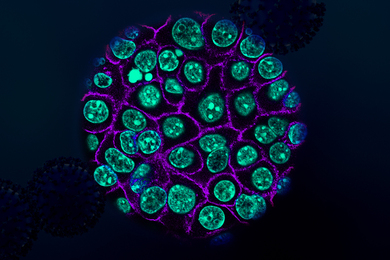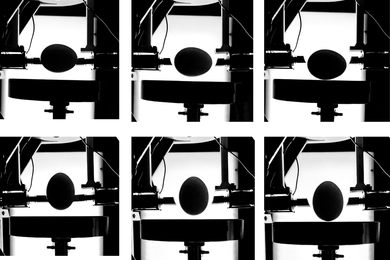Graduate student James McLurkin, inventor of the world's smallest self-contained autonomous robots measuring a little over one inch on a side, is the winner of the ninth $30,000 Lemelson-MIT Student Prize for inventiveness.
The 30-year-old native of Baldwin, N.Y., is working on his Ph.D. in computer science and building a fleet of small autonomous robots that work cooperatively to accomplish tasks.
As part of his doctoral research, McLurkin is developing algorithms and techniques for programming these swarms of robots programmed to mimic the behavior of bees: cluster, disperse, follow and orbit. By simulating the complex interactions of bees, McLurkin's robots accomplish individual tasks that support the collective goal of the group.
"James is a clever and inspired inventor," said Professor Rodney A. Brooks, director of the Artificial Intelligence Laboratory. In a letter of recommendation for the prize, Brooks said, "In the future, the world will be full of teams of mobile robots and they will all trace their ancestry to those developed by James McLurkin while still a student at MIT."
Fascinated with the process of invention since he was seven, McLurkin spent much of his childhood reconstructing and enhancing toys and electronic devices. Before he graduated from high school, he already had programmed his own video games, dismantled and rebuilt parts of his bicycle, assembled a customized computer, and designed and built two robots. Influenced by his parents' love of nature, he also began to develop a keen interest in exploring and learning from the principles of nature.
A firm believer that microrobotics should begin with the study of natural phenomena, McLurkin decided to focus his MIT undergraduate thesis project on simulating the behavior of an ant colony using 12 cubic-inch robots (MIT Tech Talk, April 26, 1995). While working on the project, he stored a large container of ants on his desk to study the way they interacted, communicated and performed tasks. He programmed his robotic ants to respond to their environment, enabling them to hunt for food, pass messages to one another and even play tag. "Understanding nature is the key to unlocking the secrets of intelligence," McLurkin said.
Recognizing the enormous potential for tasks his robots could accomplish if they could self-organize, McLurkin later expanded his research to focus on developing distributed computing techniques to enable swarms of robots to act as a group as well as individually. Swarm robots travel in a fleet. Once a discovery is made by one robot, it will signal the group. The swarm can then unite around the discovery and accomplish the task it was programmed to achieve.
As lead scientist at iRobot in Somerville, he managed a research team that built more than 100 small robots equipped to communicate with each other, compute their relative positions and utilize touch-sensing for navigation. The swarm robots are four and a half inches per side, making them 125 times larger and immensely more powerful than his robotic ants. Now part of his doctoral thesis research, each robot has bump sensors, light sensors, a self-charger, a radio modem and an audio system. Eventually, each will be equipped with a food sensor, trail sensors and a camera.
McLurkin earned his bachelor's degree in electrical engineering and expects to complete his Ph.D. in 2006. Before returning to MIT for graduate school, he earned his master's degree in electrical engineering from the University of California at Berkeley.
McLurkin is one of the inventors now being showcased in a traveling exhibition at Boston's Museum of Science (MIT Tech Talk, Oct. 23, 2002). "Invention at Play" is sponsored by the Lemelson Center for the Study of Invention and Innovation and was first shown at the Smithsonian's National Museum of American History. For more information, visit http://www.si.edu/lemelson/centerpieces/iap. For more information on the Lemelson Foundation, see http://web.mit.edu/invent.
A version of this article appeared in MIT Tech Talk on February 26, 2003.






